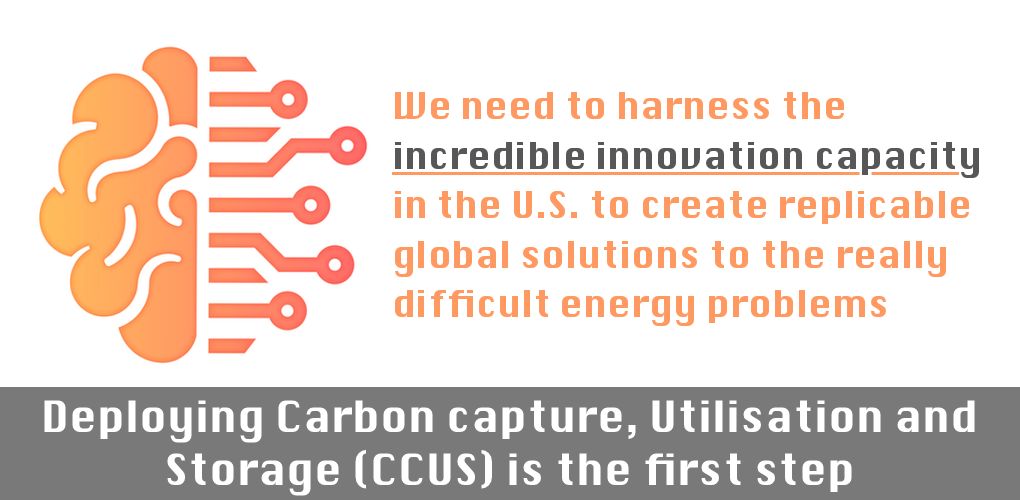
The Path Forward Goes Through CCUS
Does the world have the technology solutions it needs to decarbonize? The answer, according to the International Energy Agency (IEA) and technologists, including Bill Gates, is a resounding no.
The ongoing debate about and relentless focus on near-term national emissions goals misses the bigger, far more important picture. The U.S. is likely to contribute 5% of global emissions over the next 80 years. In addition to getting our own house in order, the 95% problem – rising global emissions driven by developing nations and emerging economies – desperately needs our focus and our capacity to innovate.
As Bill Gates recently told Fortune magazine, “in the U.S., we’re not just innovating for own citizens, we’re also innovating on behalf of everyone else.” What Gates proposes as U.S. climate leadership is harnessing the incredible innovation capacity in the U.S. to create solutions to the really difficult energy problems, such as creating emissions-free steel and cement or how to decarbonize aviation and agriculture. Gates’ interest lies in how the U.S. can create replicable global solutions for a global challenge.
And with this global perspective, it’s no coincidence that he’s putting some of his own capital behind carbon capture technology. Carbon capture utilization and storage (CCUS) is one of the nascent technologies essential to effectively reducing global emissions.
As the IEA’s Executive Director, Dr. Fatih Birol, testified to Congress in February, “for me, the critical – perhaps the most critical [technology] – is carbon capture utilization and storage. Extremely important one looking at the current energy infrastructure we have around the world.”
Dr. Birol and other energy experts and problem solvers recognize that effective solutions aren’t fairytales about a complete overhaul of the world’s energy infrastructure and heavy industries. Replicable solutions must provide cost-effective approaches to reduce or capture emissions from the infrastructure, fuels and energy investments the world leans on for secure, affordable and reliable energy.
The Biden administration seems to be getting the message. On the campaign trail, President Biden called to “double down on federal investments and enhance tax incentives for CCUS.” His newly minted Secretary of Energy, Jennifer Granholm, the former governor of Michigan, is following through on that ambition. She recently told E&E News, “We’re really interested in carbon capture, use and sequestration [CCUS] on all fossil fuels.”
She elaborated on the administration’s interest, saying, “The Intergovernmental Panel on Climate Change has said that you can’t get to net-zero carbon emissions without carbon capture, utilization and storage (CCUS). We are excited about that. Obviously, it’s still nascent technology in capturing CO2 emissions, but we’ve got to do it on all types of fuel, if we’re going to get to net zero.”
Her focus on “all fuels” is an important one. What she seems to recognize is the foundational role fossil fuels continue to play in meeting the world’s energy needs. Despite reduced use in the U.S. and Europe, coal remains the world’s leading fuel for electricity generation and a key input alongside iron to produce 70% of the world’s steel. U.S. leadership on emissions runs through coal technology, not around it.
Harnessing the nation’s remarkable innovation capacity should be the tip of the spear of our climate leadership and it should also be complemented with efforts to accelerate near-term deployment of some of these critical, emerging technologies, with CCUS right at the top of the list. Expanding the time window to claim 45Q carbon capture tax credits and allowing for a direct payment option for developers are obvious, important actions Congress can take right now to expand the deployment pipeline. Representatives David McKinley (R-W.Va.) and Marc Veasey’s (D-Texas) “ACCESS 45Q Act,” H.R. 1062, would do just that. This bipartisan effort is exactly the smart, actionable legislation Congress should embrace.
Bipartisan agreement is building behind the need for a sharp ramp-up in energy research, development and deployment investment by the federal government. It seems to be the right path to not only provide the solutions the U.S. needs to effectively reduce emissions without imposing crushing costs on consumers or damaging grid reliability, but to also provide the leadership the world needs. Globally scalable solutions are the challenge and the opportunity. As Bill Gates observed, “if you can’t solve this problem for the world, it’s not worth solving at all.”
- On March 10, 2021
